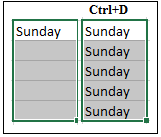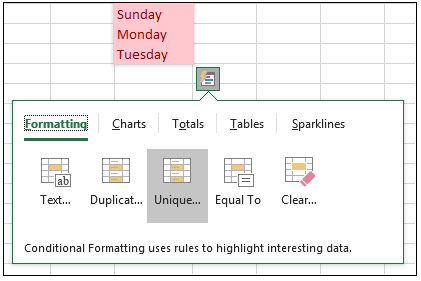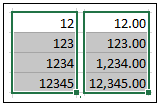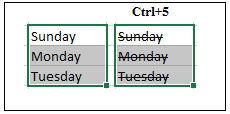Microsoft Excel shortcut keys
If you work on Microsoft Excel, you can use the number of keyboard shortcut keys to speed up your work and make it more convenient. We have tried to provide a simple list of shortcut keys.
The following table contains the commonly used shortcut keys for Microsoft Excel with description.
| Shortcut Keys | Description |
|---|---|
| Ctrl+Shift + ; | It is used to insert the current time. |
| Ctrl+; | It is used to enter the current date. |
| Shift + F3 | Its use is to open the Excel formula's window.' |
| Shift + F5 | It provides users the option to display the find and replace dialog box. |
| Ctrl + A | Its use is to select or highlight all contents of a worksheet. |
| Ctrl + B | It allows you to bold all selected items of an Excel sheet. It can also be done by pressing Ctrl+2. |
| Ctrl + C | It is used to copy the selected content of a worksheet. |
| Ctrl + D | It enables you to fill down the cells with the content of the selected cell. As shown in the below picture: |
| Ctrl + F | It offers the option to open find and replace dialog box quickly. You can also use Shift + F5 for it. |
| Ctrl + G | It is used to open the go-to option dialog box where you can go to the specific cell. It can also be done by using F5. |
| Ctrl + H | It allows you to find and replace the word or sentences in a file. For example, if by mistake you have written a somputer instead of the computer at many places in your sheet, you can replace it with the computer in one go. |
| Ctrl + I | It is used to put italics on all cells in the selected section. It can also be done by pressing Ctrl+3. |
| Ctrl + K | It provides the option to insert a hyperlink in a file. |
| Ctrl + L | It enables you to access the create table dialog box. |
| Ctrl + N | Its use is to open the new document or a workbook. |
| Ctrl + O | It offers users the option to open the dialog box where you can choose a file that you want to open. You can also use Ctrl+F12 to open a file. |
| Ctrl + P | It allows you to print a current sheet or a document quickly. |
| Ctrl + Q | It is used to display the quick analysis options for the selected cells with data. As shown in the below image: |
| Ctrl + R | It allows you to fill the cells to the right with the content of the selected cell. As shown in the below screenshot: |
| Ctrl + S | Its use is to save the document. It can also be done by using Alt+Shift+F2. |
| Ctrl + T | It offers users the option to display the create table dialog box. |
| Ctrl + U | It is used to underline all selected cells. You can also use the shortcut key Ctrl+4 to underline the cells in the Excel sheet. |
| Ctrl + V | It provides users the option to paste the copied data onto the Excel sheet. You are required to copy the data once, and then you can paste it any number of times. |
| Ctrl + W | It is used to close the currently open document or a file quickly. It can also be done by pressing Ctrl+F4 shortcut keys. |
| Ctrl + X | It allows users the option to cut the entire data of the selected cells in an Excel sheet. |
| Ctrl + Y | It provides users the option to redo any undo contents. |
| Ctrl + Z | It is used to undo (get back) the deleted item. For example, if you have deleted the data by mistake, you can press Ctrl+Z to retrieve the deleted data. It can also be done by pressing Alt+Backspace. |
| Ctrl + Page up & Page Down | It allows you to move from one worksheet to another worksheet in the same Excel file. |
| Ctrl + F6 | It enables the users to move from one document to another document in Microsoft Excel. It can also be done by pressing Ctrl+Tab. |
| Ctrl + F9 | It enables users the option to minimize the current window. |
| Ctrl + F10 | It uses to maximize the currently selected window. |
| F1 | It is used to open the help screen window. |
| F2 | It allows you to edit the selected cell in the Excel sheet. |
| F4 | It provides users the option to repeat the last action. For example, if you change the red color of the text in a cell, by pressing F4, you can apply the same text color in another cell. |
| F7 | It is used to check the spelling of the selected text. |
| F10 | The function key F10 is used to activate the menu bar. For example, if you want to open the file menu, you need to press F10, then F. |
| F11 | Its use is to create a chart in Excel. |
| F12 | It enables you to use the Save As option, which allows you to save a file with a different name. It can also be done by using Alt+F2. |
| Alt + = | It allows you to use the formula to add the data of all the above cells. |
| Ctrl+Shift+" | It allows you to copy the content of a cell and to paste it into a cell, which is just below it. It can also be done by using Ctrl+" key. For example, if you have written "Excel" in cell B1 and its below cell is B2, by pressing Ctrl+Shift+" or Ctrl+' the word "Excel" will be copied in cell B2. |
| Ctrl + Shift + ! | It is used to apply comma format in numbers. For example, as shown in the below image: |
| Ctrl + Shift + $ | Its use is to apply currency format to numbers. As shown in the below screenshot: |
| Ctrl + Shift +% | It provides users the option to apply percentage sign to numbers. For example, see the below picture: |
| Ctrl + Space | It enables you to select the entire active columns. |
| Shift + Space | It enables you to select the entire active rows. |
| Ctrl + (Right arrow →) | It allows the users to move the cursor to the next cell, which contains the text. |
| Ctrl + 1 | It is used to open the format cells dialog box where you can change the text format like text color, font size, font style, text alignment, etc. It can also be done by pressing Ctrl+Shift+F or Ctrl+Shift+P. |
| Ctrl + 5 | Its use is to put the strikethrough to all selected cells. As shown in the below picture: |
| Ctrl + 9 | Its use is to hide the selected rows in the worksheet. |
| Ctrl + Shift + ( | Its use is to show (unhide) the hidden rows. |
| Ctrl + 0 | It is used to hide the selected columns. |
| Ctrl + - (Minus) | It will open a delete dialog box where you can delete a selected row or column. |
| Ctrl + Shift + = | It will open the insert dialog box where you can insert the new row or a column. |
| Ctrl + Shift + ^ | It is used to make an exponential form of any number. For example, you have written a number 12345 in the worksheet, and if you press Ctrl+shift+^, the number will be changed 1.23E+05 in exponential form. |
| Ctrl + Shift + & | It offers users the option to make a border around the selected cells. |
| Ctrl + Shift+ _ | It offers users the option to remove a border around the selected cells in a worksheet. |
| Ctrl+Shift+Spacebar | It is used to select the entire worksheet. |
| Ctrl + Home | It allows the users to move the cursor to the beginning (cell A1) of the worksheet. |
| Ctrl + End | It is used to move the cursor to the last cell with text on the worksheet. |
| Shift + Page Up | It allows you to select all the cells located above the selected cell. |
| Shift + Home | It enables you to select all cells to the left of the current active cell. |
| Shift + (Up Arrow ↑) | It enables you to extend the selected area up by one cell. |
| Shift + (Down Arrow ↑) | It enables you to extend the selected area down by one cell. |
| Alt + Enter | It allows the users to write in multiple lines in one cell. For example, if you are typing in a cell, it enables you to move on the next line in one cell by pressing Alt+Enter. |
| Alt + ' | It is used to access the style dialog box. |
| Ctrl + F3 | It is used to open the name manager in Microsoft excel. |
| Ctrl + F5 | Its use is to restore the Window size. |
| Ctrl + F11 | It is used to insert a macro sheet in Microsoft excel. |
| Alt + F8 | It is used to display the macro dialog box. |
| Alt + F11 | It provides users the option to open the Visual Basic editor. |
| Alt + Shift + F1 | It enables you to create a new worksheet in Microsoft Excel. |
No comments:
Post a Comment